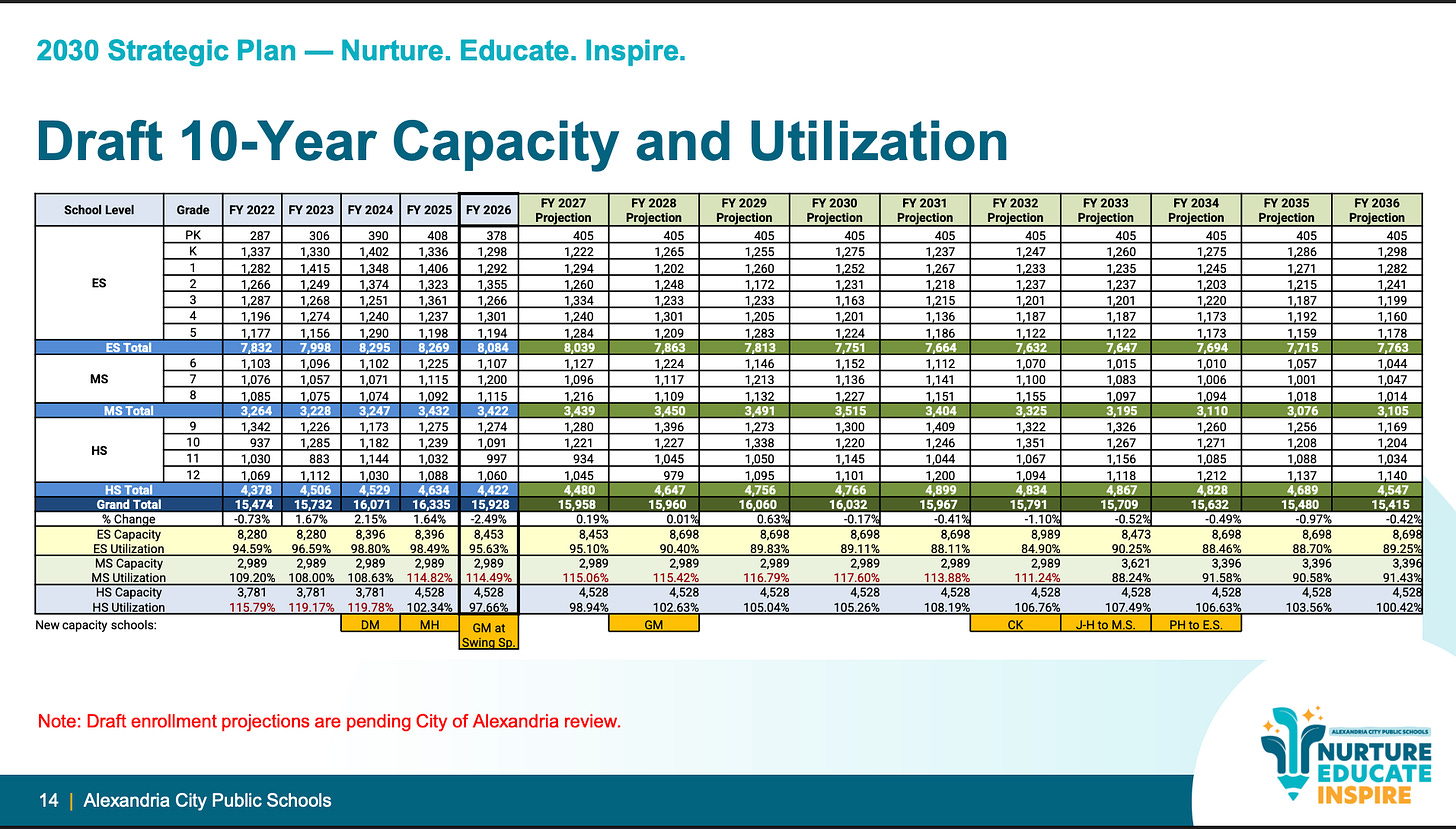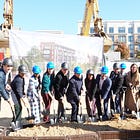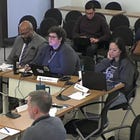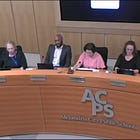ACPS presentation shows enrollment decline, proposes modular classrooms for middle schools
School board holds second work session on capital budget tonight
Update: This article was updated at 12:40 p.m. on Tuesday, November 18 to clarify that Option B would convert both Jefferson-Houston and Patrick Henry from K-8 to K-5 elementary schools, and that Option D would cancel or delay the Cora Kelly modernization project.
Alexandria City Public Schools’ school board will hold its second work session on the proposed $340.4 million capital improvement program tonight, focusing on enrollment projections and middle school capacity solutions after the district experienced a 2.5% enrollment decline this fall.
The work session, scheduled for 6 p.m. in the school board meeting room, will examine fiscal years 2028-2036 of the capital plan, including proposals to add modular classrooms at both middle schools and convert Jefferson-Houston into an 850-student middle school by fiscal 2033.
The meeting is open to the public, and it can also be viewed live via Zoom.
Enrollment decline mirrors regional trend
ACPS enrollment fell to 15,928 students this fall, down 407 students from 16,335 in fall 2024, according to a presentation prepared for the meeting. The 2.5% decline follows a regional pattern, with preliminary data showing Fairfax County down 3,000 students, Montgomery County down 2,600, Loudoun County down 1,000, and Arlington County down 300.

The district had projected 16,545 students for the 2025-26 school year, but actual enrollment came in 617 students lower, a 96.3% accuracy rate. Middle school enrollment was 98.4% of projections, while high school enrollment was 93.6% of what the district expected.
Elementary enrollment dropped 185 students (2.2%), grades 6-8 dropped 10 students (0.3%), and grades 9-12 dropped 212 students (4.6%) compared to last year.
Draft projections show middle school capacity crunch easing
Draft 10-year enrollment projections show middle school enrollment peaking at 3,515 students in fiscal 2031 before declining to 3,105 students by fiscal 2036, according to presentation materials.
With current middle school capacity at 2,989 seats, the district projects utilization rates above 110% from fiscal 2027 through fiscal 2032. However, after Jefferson-Houston converts to a middle school in fiscal 2033, adding 632 middle school seats, utilization drops to 88.2% and remains below 92% through fiscal 2036.

Elementary school enrollment is projected to remain relatively stable, ranging from 7,632 to 8,114 students through fiscal 2036. High school enrollment is projected to range from 4,422 to 4,899 students over the same period.
The projections are pending review by the City of Alexandria, according to presentation materials.
Modular classrooms proposed as short-term solution
School staff will present a proposal to add modular classrooms at both Francis Hammond and George Washington middle schools to address capacity needs until the Jefferson-Houston conversion is complete.
The proposal calls for installing eight modular units at each middle school site, providing 443 additional seats. Implementation would require 9-12 months for procurement, installation, and furnishing, with the modular units intended for use for a maximum of five years.

The cost for 16 modular classrooms would range between $12.7 million and $15.9 million without escalation, including furniture, fixtures, equipment, data, design, construction, utilities, and ADA requirements, according to the presentation.
“The most viable option is the use of modular units,” the presentation states, noting that more than one location on each site would be needed to accommodate eight modulars per campus.

Alternative capacity scenarios
The presentation outlines four capacity scenarios for board consideration, ranging from the proposed plan to alternatives that would convert Cora Kelly into a middle school or accelerate the Jefferson-Houston conversion.

Option A, the proposed plan, includes the Cora Kelly elementary modernization and the Jefferson-Houston and Patrick Henry conversions, with a 10-year capital cost of $144.7 million for the three projects. This option would result in 91.4% middle school utilization by fiscal 2036.
Option B would convert Cora Kelly into a middle school while also converting both Jefferson-Houston and Patrick Henry from K-8 schools to K-5 elementary schools, with a 10-year cost of $158.9 million. This option would achieve 91.4% middle school utilization.
Option C would convert Cora Kelly to a middle school and the George Mason swing space building (1703 N. Beauregard) into an elementary school with a gymnasium addition. This option costs $146.8 million and would result in 80.9% middle school utilization, eliminating the need for additional swing space during future school renovations.
Option D would accelerate the Jefferson-Houston middle school conversion and Patrick Henry K-5 conversion while also converting 1703 to an elementary school with a gymnasium. This option costs $46.5 million for capacity projects and would achieve 91.4% middle school utilization. This option would cancel or significantly delay the Cora Kelly modernization project. Options C and D would help meet city budget guidance by reducing overall capital costs.
Current utilization shows capacity imbalances
Fall 2025 enrollment data shows significant variation in school utilization rates across the district. Several schools are operating above the district’s target utilization range of 90-110%, including John Adams at 126%, George Washington Middle School at 131%, Francis Hammond Middle School at 113%, ACHS Minnie Howard at 117%, Patrick Henry at 118%, Samuel Tucker at 112%, and Mount Vernon at 116%.
Meanwhile, other schools are under-enrolled, including Cora Kelly at 81%, George Mason at 66% and Jefferson-Houston at 76%.
Major development expected
The district is tracking 14 major residential developments expected to deliver between now and 2029 that are projected to generate more than 20 students each, according to city data. The largest developments include Housing Alexandria’s Sanse & Naja Building 1A, projected to bring 124 students, Samuel Madden North Building, projected for 137 students, and Samuel Madden South Building, projected for 89 students.
Next steps
The work session is the second of four meetings on the capital budget before final adoption scheduled for Dec. 18. Board members’ formal written questions were due Nov. 17.
The board will hold add/delete sessions on Dec. 11 and Dec. 16, where members can propose changes to the superintendent’s recommended budget. The board will also hold a joint work session with the City Council on Nov. 24 to discuss capital improvement priorities.
The proposed 10-year capital plan totals $340.4 million, exceeding city guidance by $54.6 million.
The first work session, on Nov. 13, focused on the fiscal 2027 budget and drew public comments from two Jefferson-Houston parents opposing the school conversion plan.




